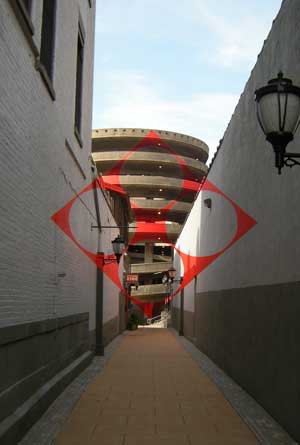Felice Varini at Temple Plaza and Main Ives Library
Felice Varini: Three black circles in the air
Main Ives Library, New Haven, CT, www.siteprojects.org, Through December 31, 2010
All painting is a matter of illusion, of course, but seldom so self-conscious and on such an expansive scale as this most recent commission by Felice Varini. Described as the prolific artist’s first “outdoor work” in this country (he has previously done interior installations in Miami and New York), the painted patchwork extends several hundred feet both horizontally and vertically across an assortment of architectural surfaces.
The work can be encountered from several different directions, but resolves only through a large keyhole vantage point at the end of what its sponsors describe as a “pedestrian passageway.” And here is the first hint of the problem that accompanies the piece. Why not embrace the myth of the alley and the film noir darkness that accompanies it? A light projector was used to lay out the elongated patterns of shadow that became the outlines of the design. But the results mimicked similar transformations of city walls by a fleeing Orson Welles in the movie The Third Man. One could imagine the work as a magic lantern show that would present a series of changing backgrounds with figures walking through it to twist and bend the boundaries. This was a hint that the process of assembling would turn out to be more interesting than the result.
Once the puzzle is solved in the bright light of day, there is nothing left to learn. Even on a gigantic scale, a Rubik’s Cube loses interest once the trick is revealed. Its brief lessons are in perception, not morality. A companion piece by Varini in a local library is more successful, if only because it has a smaller, more interesting space with interior entablatures and stairwell arches to play against. Still, nothing unnerving or provocative emerges here, either.
There is a sixteenth-century painting that shows two diplomats looking like those doomed minor characters in Hamlet who are sent off, oblivious, to the executioner. A distorted form in the center of the picture resolves into a skull as the viewer shifts position. Seeing that death’s head emerge is a salutary experience, especially since it comes by surprise. If Varini’s work were capable of giving some similar shock, it would be a real illusion of grandeur.
-Stephen Vincent Kobasa

